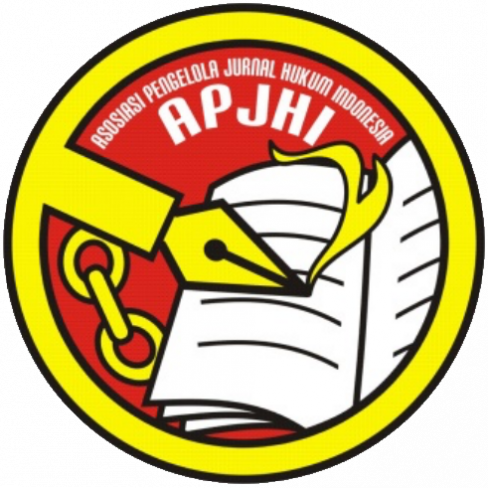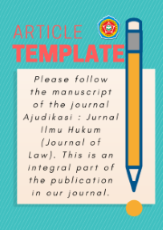Pelindungan Hukum Terhadap Konten Kreator Anak
DOI:
https://doi.org/10.30656/ajudikasi.v7i2.7908Keywords:
Protection, Legal, Content, Creators, ChildrenAbstract
Content creators are flexible workers who are in demand by all groups, both adults and children. Children in digital content creation are at risk of exploitation and psychological distress. This is the case with Monella Sunshine Jo, a 5 year old celebrity who has achieved a significant level of popularity. Although children's rights in the digital world have been regulated in legislation, adequate regulations to protect children as content creators are still lacking, creating problems that need attention. This article aims to analyze the legal regulation of child labor as a content creator on social media and the legal protection of child content creators based on labor law. The method used in this research is normative research method, which examines and analyzes the subject matter with the substance of the Legislation. Based on the results of this study it can be concluded, First, legal protection of child content creators on social media and regulations in Indonesia have regulated the rights and obligations of children as workers, especially in the entertainment industry, but there are certain conditions, stating that children who have worked must do work in accordance with their requests and talents, these provisions are regulated in the Decree of the Minister of Manpower Number KEP.115/MEN/VII/2004. Second, the protection of children from work is regulated in Law Number 13 of 2003 concerning Manpower with the exception of children aged 13-15 years who may do light work as long as it does not interfere with development and health. Conditions such as written permission, work agreement, maximum time of 3 hours, daytime, and not interfering with school. Law Number 13 of 2003 on Labor prohibits child labor that endangers health, safety, or morals, as well as involving children in slavery, prostitution, the production of pornography, and the trafficking of addictive substances.
Downloads
References
Buku
Amirudin, 2008, Pengantar Metode Penelitia Hukum, Raja Grafindo Persada, Jakarta.
Gosita, Arif, 2009, Masalah Korban Kejahatan, Universitas Trisakti, Jakarta.
Harjono, 2008, Konstitusi Sebagai Rumah Bangsa, Penerbit Sekretariat Jenderal dan Kepaniteraan, Grafindo, Jakarta.
Mamudji, Sri, 2005, Metode Penelitian dan Penulisan Hukum, Badan Penerbit Fakultas Hukum Universitas Indonesia, Jakarta.
Suyanto, Bagong, 2010, Masalah sosial anak, Kencana, Jakarta.
Soekanto, Soerjono, and Sri Mahmudji, 2003, Penelitian Hukum Normatif Suatu Tinjauan Singkat, Raja Grafindo Persada, Jakarta.
Jurnal
Agung, Anak, and Ketut Sukranatha, 2019, Tinjauan Yuridis Terhadap Pekerja Artis Dibawah Umur Dalam Perspektif Undang-Undang Pelindungan Anak, Kertha Semaya: Journal Ilmu Hukum, 6 (5).
Ajeng, Yunita, Tinjauan Yuridis Pelindungan Pekerja Anak Di Indonesia Dalam Perspektif Konvensi Hak Anak, Journal Ius Publicum, 6 (3).
Anugraha, Zakaria, 2018, Ekploitasi Anak Dibawah Umur Oleh Orang Tua Sebagai Pengemis Jalanan di Kota Mataram, Jurnal Pendidikan Sosial, 2 (4).
Agustang, Andi 2022, Dinamika Putus Sekolah Di Kalangan Pekerja Anak Di Kota Makassar, Jurnal Lentera, 2 (3).
Danayanti, Sri, 2019, Pelindungan Hukum Terhadap Anak Di Bawah Umur Yang Berpekerja Sebagai Artis Berdasarkan Undang-Undang Ketenagakerjaan, Jurnal Kertha Semaya Fakultas Hukum Universitas Udayana, 7 (7).
D. A, Nurohman 2021, Konten Kreator: Cara Kreatif Menghasilkan Uang dengan Menjadi Blogger, Youtuber atau Tiktoker. Indonesia, Journal Diksi Hukum
Fetum, 2021, PelindunganHukum bagi Pencipta dan Pemegang Hak Cipta Konten Kreator Instagram, Merdeka Law Journal, 3 (8).
Hanifah, Ida, 2020, Kebijakan Pelindungan Hukum Bagi Pekerja Melalui Kepastian Hukum, Jurnal Legislasi Indonesia, 3 (1).
Hermanto, Agus, Batas Kewajiban Anak Bekerja Dalam Kajian Hukum Keluarga Islam, Jurnal Ilmu Sosial dan Humaniora, 3 (4).
Izzati, Risfa, 2019, Pelindungan Hukum Terhadap Eksploitasi Ekonomi Artis Cilik: Sftudi Komparasi Indonesia Dan Amerika Serikat, Arena Hukum, 4 (2).
Kalangie, Heski, 2014, Pelindungan Hukum Atas Hak Pekerja Anak Dalam Sektor Informal Di Indonesia, Lentera Hukum, 6 (2).
Melisa, Mongi, Mebby, 2016, Pelindungan Terhadap Artis Cilik Dalam Prespektif Hukum HAM, Crime Journal, 4 (2).
Ni Luh Putu Devi Wirasasmita dan Made Nurmawati, 2019, Analisis Terhadap Pekerja Artis Di Bawah Umur Sebagai Bentuk Eksploitasi Anak Berdasarkan Undang-Undang Pelindungan Anak, Jurnal Kertha Wicara Fakultas Hukum Universitas Udayana, 7 (1).
Nurjannah, Rizky, Childfree Dalam Perspektif Islam (Studi Kasus Konten Kreator Youtube Gita Savitri Devi), Jurnal Fundamental Justice, 5 (1).
Putri, Endarwati, 2019, Faktor Anak Bekerja dan Upaya Pencegahan (Studi Kasus di Kota Semarang), Jurnal Dinamika Hukum, 3 (4).
Ratna, Adelia, 2016, Pelindungan Hukum Terhadap Artis Anak, Arena Hukum, 5 (2).
Rahma, Rina, 2022, Pelindungan Hukum Terhadap Hak Pekerja Anak Di Indonesia, Unes Journal Of Swara Justisia, 4 (2).
Rosiah, Anisa, 2016, Pekerja Anak Dan Praktek Pelindungan Hak-Hak(Studi Kasus Pekerja Rumah Tangga Anak Di Slemanyogyakarta), Jurnal Riset Ilmu Hukum, 5 (2).
Sari, Lisa Kurnia, 2022, Analisis Exploitasi Pekerja Anak Dari Sisi Pendidikan Di Pulau Jawa, Jurnal Statika, 4 (3).
Sudary, Rini Irianti, 2021, Perlindungan Hukum terhadap Pekerja Anak dihubungkan dengan Hak Atas Pendidikan Studi Kasus di Provinsi Jawa Barat, Jurnal Riset Ilmu Hukum, 4 (2),
Ulfa, Maulina, 2019, Pelindungan Sosial Bagi Pekerja Ekonomi Gig, Jurnal Senaya, 2 (1).
Hidayat, Syarifuddin, and Ahmad Mahyani, 2017, Pelindungan Hukum Bagi Anak Korban Eksploitasi Sebagai Artis, Mimbar Keadilan, 12 (7).
Peraturan Perundang-Undangan
Kitab Undang - Undang Hukum Perdata (KUHPer)
Undang - Undang Nomor 13 Tahun 2003 Tentang Ketenagakerjaan.
Skripsi
Giting, Ayam, 2011, Tinjauan Yuridis Pekerja Artis Di Bawah Umur Sebagai Bentuk Eksploitasi Terhadap Anak. Repositori Universitas Sumatra Utara.
Downloads
Published
Issue
Section
License
Authors who publish with this journal agree to the following terms:
Authors retain copyright and grant the journal right of first publication with the work simultaneously licensed under a Creative Commons Attribution License that allows others to share the work with an acknowledgment of the work's authorship and initial publication in this journal.
Authors can enter into separate, additional contractual arrangements for the non-exclusive distribution of the journal's published version of the work (e.g., post it to an institutional repository or publish it in a book) with an acknowledgment of its initial publication in this journal.
Authors are permitted and encouraged to post their work online (e.g., in institutional repositories or on their website) before and during the submission process, as it can lead to productive exchanges and earlier and greater citation of published work.
All articles in Ajudikasi : Jurnal Ilmu Hukum can be disseminated provided they include the identity of the article and the source of the article (Ajudikasi : Jurnal Ilmu Hukum). The publisher is not responsible for the contents of the article. The content of the article is the sole responsibility of the author
Ajudikasi : Jurnal Ilmu Hukum is lincensed under a Creative Commons Attribution-ShareAlike 4.0 International License.









1.png)
.png)
.png)





.png)
.png)
.png)
.png)





.png)







